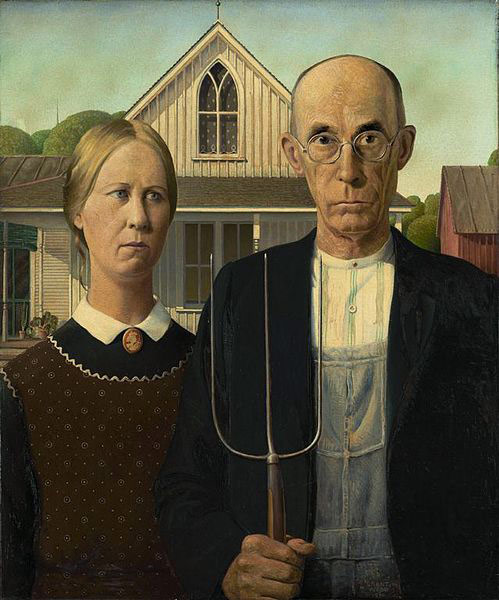| American Gothic | |
|---|---|
 |
|
| Artist | Grant Wood |
| Year | 1930 |
| Medium | Oil on beaverboard |
| Location | Art Institute of Chicago |
| Dimensions | 29.25 in × 24.25 in |
| 74.3 cm × 62.4 cm | |
American Gothic is a painting by American artist Grant Wood in 1930. Shown is a farmer and his spinster daughter in front of their house. The models on the painting were Wood’s sister, Nan, wearing a colonial print apron mimicking 19th century Americana, and Wood’s dentist, Dr. Byron McKeeby from Iowa.
Wood painted the house along with the people he imagined might live there. The house actually exists in Eldon, Iowa. It was built in the American Gothic style. The models never sat in front of the house, and each element was painted separately. The painting measures 29.25 inches by 24.5 inches, which is equivalent to 74.3 cm by 62.4 cm.
The Artist: Grant Wood
Grant Wood was born on February 13, 1892 in Iowa. After the death of his father in 1901, his family moved to Cedar Rapids where he began as an apprentice at a metal shop. He enrolled at an art school in 1910 in Minneapolis, Minnesota. In 1913, he attended the Art Institute of Chicago where he worked as a silversmith. From 1934 to 1941, he taught painting at the University of Iowa’s School of Art. A day after celebrating his 51st birthday in 1942, Wood died of liver cancer at the university’s hospital. Wood had been influenced by the works of 15th century Flemish artist Jan Van Eyck. Other famous paintings by Grant Wood include: The Little Chapel Chancelade (1926), Woman with Plants (1929) And John B. Turner, Pioneer (1929).
Painting Inspirations
Wood saw the house while travelling through the Iowa landscape in the summer of 1930, he was inspired. Some people thought that Grant Wood was making fun of small town folk. The house had an unusual window. The design is based on Gothic architecture which originates from Europe, as opposed to an American farmhouse. The contrast caught the artist’s attention that led to the painting of American Gothic.
Reception of the Painting
Wood entered American Gothic at a competition sponsored by the Art Institute of Chicago. Initially, the judges viewed it as a comic valentine. However, a patron convinced them to award it a bronze medal and a cash prize of $300. The Art Institute bought the painting where it remains to this day. Soon after, the painting began to appear in newspapers.
When the image finally appeared in the Cedar Rapids Gazette, Iowans became furious. A woman threatened to bite Wood’s ear off. However, Grant explained that his intention was not to misrepresent Iowans, but to portray America as a whole. The arrival of the Great Depression was upon the country, the painting was seen as a portrayal of the steadfast American pioneer spirit.
Artistic Features
The painting is obviously fictional in many ways. First, it has a 19th century theme painted in the 20th century. Second, the title itself refers to the architecture of the house, with the artist taking liberty to add the type of people he believed who may live there. The house’s medieval style window looks like one you may find at a church, in fact the potted plants on the porch and the decorative blind distinguishes the wooden house from a church.